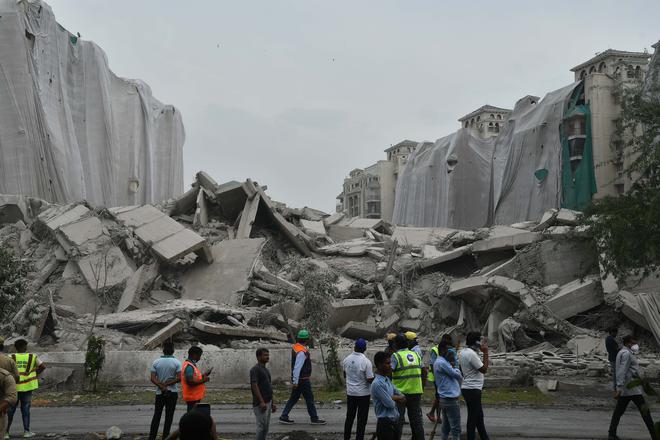The countdown started at exactly 50 seconds past 2:29 p.m. Ten seconds later, the twin towers — the 32-storeyed Apex tower and 29-storeyed Ceyane tower had stood tall for the last 10 years at Noida Sector 93A — would disappear from view. The over 100-metre-high structures, taller than the Qutub Minar, were reduced to 85,000 kg of debris and a thick cloud of dust.
Read | Noida twin towers demolition: Timeline of key events
Soon after the cloud of dust settled, a team from Edifice Engineering and South Africa’s Jet Demolitions, the two companies that carried out the task, along with officials of the Central Building Research Institute (CBRI) and the Noida Authority, began a structural audit of the adjoining buildings. A clean chit was given to all the surrounding buildings later in the evening.
Water sprinklers and anti-smog guns were activated at the site to dispel the dust, an official said.
Insurance cover
“We have secured a ₹100-crore insurance for any post-demolition damage. We will fix any damage caused to nearby buildings,” said Utkarsh Mehta, founder, Edifice Engineering.
Joe Brinkman, detonation expert and managing director of Jet Demolition, said that 9,642 holes were drilled into the twin towers, which had housed over 900 flats and shops, in the span of six months.
The firm applied the waterfall mechanism in the demolition of the twin towers, causing the debris to collapse vertically without damaging the adjacent buildings.
“The controlled detonation of around 3,700 kg of explosives brought down the twin towers. Also, with this exercise, India has also joined a select group of countries where controlled explosion over-100-metre-tall buildings has been done,” said Mr. Brinkman, who could not hold back his tears.
Tears of happiness
“There was a lot of pressure. These were the tears of happiness and success,” he added.
Both Jet Demolition and Edifice Engineering placed vibration-monitoring systems at the site, along with a black box, to help them study the demolition in detail. IIT-Chennai will also participate in the study.
In its first statement issued since the order to demolish the buildings was issued by the Supreme Court a year ago, Supertech builders on Sunday said that the twin towers were constructed as per the building plan approved by Noida development authorities and that no deviations had been made.

About 5,000 people from the adjoining Emerald Court and ATS Village societies had left their homes a few hours before the demolition. Nearly 3,000 vehicles and about 200 pets were moved out of harm’s way.
Legal background
The Supreme Court had ordered the demolition of the towers, on August 31, 2021, for having violated building norms in “collusion with district officials. It held that illegal construction had to be dealt with strictly to ensure compliance with the rule of law”.
The Apex Court had lambasted the Noida Authority, as the court pointed out multiple incidents of collusion between its officials and Supertech in the Emerald Court project and violations of norms by the realty major in the construction of the twin towers.
“The case has revealed a nefarious complicity of the planning authority in the violation by the developer of the provisions of law,” the Supreme Court had observed.
The top court had ordered Supertech to bear the cost of the demolition as it noted that the construction of the twin towers, which was not part of the original plan for Emerald Court, directly affected the quality of life of its residents.
There is only one other precedent of high-rise structures in India being demolished. In January 2020, four housing complexes in the Maradu municipality area of Kochi, Kerala, were brought down in compliance with the Supreme Court’s orders — the 18-20 storey buildings were held to be illegal as they had been built in violation of Coastal Regulation Zone norms.







